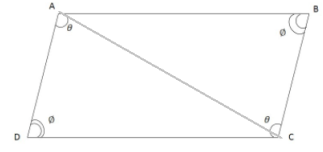
Prove that: In a parallelogram, opposite angles are equal.
Answer
556.2k+ views
Hint: We know that the opposite sides of the parallelogram is parallel. Now drawing a transversal line AC, in the parallelogram ABCD, the alternate angle becomes equal and we get two different equations. Adding these both equations, at last , we prove that the opposite angles of the parallelogram are equal.
Complete step-by-step answer:

It is already given in the question that a parallelogram ABCD has AC as its one of the diagonal.
To prove:- $\angle $A = $\angle $C and
$\angle $B = $\angle $D.
Proof:- Opposite sides of parallelogram is parallel.
So, AB$\parallel $CD and AD$\parallel $BC.
Since, AB$\parallel $CD;
And AC is the transversal.
$\angle $BAC = $\angle $DCA ( They are the Alternate angles)
So,$\angle $ BAC = $\angle $DCA …(1)
Now, Since, AD$\parallel $BC;
And AC is the transversal.
$\angle $DAC = $\angle $BCA (They are the Alternate angles)
So, $\angle $DAC = $\angle $BCA ….(2)
Adding both the equations, that is equation (1) and (2) , we get;
$ \Rightarrow $$\angle $BAC + $\angle $DAC = $\angle $DCA + $\angle $BCA
$ \Rightarrow $ $\angle $BAD = $\angle $DCB.
$ \Rightarrow $ $\angle $A = $\angle $C.
In the similar way only;
We can prove that:- $\angle $ADC = $\angle $ABC
$ \Rightarrow $ $\angle $D = $\angle $ B.
Hence, it is proved that in a parallelogram , the opposite sides of parallelogram are equal.
Note: In order to solve this particular question, we need to memorize these properties of parallelogram:-
a.) The opposite sides are congruent.
b.) The opposite angles are congruent.
c.) The consecutive angles are supplementary.
d.) If anyone of the angles is a right angle, then all the other angles will be the right angle.
e.) The two diagonals bisect each other.
Complete step-by-step answer:

It is already given in the question that a parallelogram ABCD has AC as its one of the diagonal.
To prove:- $\angle $A = $\angle $C and
$\angle $B = $\angle $D.
Proof:- Opposite sides of parallelogram is parallel.
So, AB$\parallel $CD and AD$\parallel $BC.
Since, AB$\parallel $CD;
And AC is the transversal.
$\angle $BAC = $\angle $DCA ( They are the Alternate angles)
So,$\angle $ BAC = $\angle $DCA …(1)
Now, Since, AD$\parallel $BC;
And AC is the transversal.
$\angle $DAC = $\angle $BCA (They are the Alternate angles)
So, $\angle $DAC = $\angle $BCA ….(2)
Adding both the equations, that is equation (1) and (2) , we get;
$ \Rightarrow $$\angle $BAC + $\angle $DAC = $\angle $DCA + $\angle $BCA
$ \Rightarrow $ $\angle $BAD = $\angle $DCB.
$ \Rightarrow $ $\angle $A = $\angle $C.
In the similar way only;
We can prove that:- $\angle $ADC = $\angle $ABC
$ \Rightarrow $ $\angle $D = $\angle $ B.
Hence, it is proved that in a parallelogram , the opposite sides of parallelogram are equal.
Note: In order to solve this particular question, we need to memorize these properties of parallelogram:-
a.) The opposite sides are congruent.
b.) The opposite angles are congruent.
c.) The consecutive angles are supplementary.
d.) If anyone of the angles is a right angle, then all the other angles will be the right angle.
e.) The two diagonals bisect each other.
Recently Updated Pages
Two men on either side of the cliff 90m height observe class 10 maths CBSE

What happens to glucose which enters nephron along class 10 biology CBSE

Cutting of the Chinese melon means A The business and class 10 social science CBSE

Write a dialogue with at least ten utterances between class 10 english CBSE

Show an aquatic food chain using the following organisms class 10 biology CBSE

A circle is inscribed in an equilateral triangle and class 10 maths CBSE

Trending doubts
Why is there a time difference of about 5 hours between class 10 social science CBSE

Write a letter to the principal requesting him to grant class 10 english CBSE

What is the median of the first 10 natural numbers class 10 maths CBSE

The Equation xxx + 2 is Satisfied when x is Equal to Class 10 Maths

Which of the following does not have a fundamental class 10 physics CBSE

State and prove converse of BPT Basic Proportionality class 10 maths CBSE




